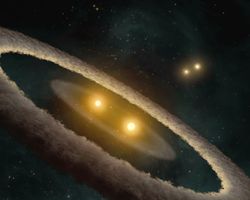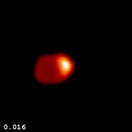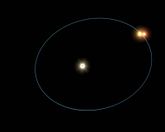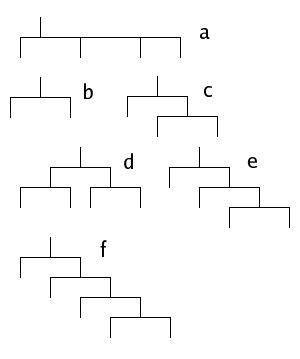نظام نجمي
| |||
| |||
النظام النجمي هو عبارة عن مجموعة صغيرة من النجوم تدور جول بعضها و ترتبط بقوى جذب. يقدر العلماء أن أكثر من ثلث نجوم مجرتنا مرتبطة بأنظمة نجمية. تنقسم الأنظمة النجمية إلى نوعين: النجوم الثنائية والنجوم المتعددة. النجم الثنائي يتكون من نجمين فقط، أما نظام النجم المتعدد فربما يصل عدد النجوم فيه إلى 6 أو7. الأعداد الكبيرة من النجوم و التي ترتبط بقوى جذب تسمى تجمع نجمي. النظام النجمي قد يستخدم أيضاً للإشارة إلى نظام من نجم واحد و كواكب تدور حوله.
أنظمة تراتبية
Most multiple-star systems are organized in what is called a hierarchical system: the stars in the system can be divided into two smaller groups, each of which traverses a larger orbit around the system's center of mass. Each of these smaller groups must also be hierarchical, which means that they must be divided into smaller subgroups which themselves are hierarchical, and so on.[2] Each level of the hierarchy can be treated as a two-body problem by considering close pairs as if they were a single star. In these systems there is little interaction between the orbits and the stars' motion will continue to approximate stable[3][4] Keplerian orbits around the system's center of mass,[5] unlike the unstable trapezia systems or the even more complex dynamics of the large number of stars in star clusters and galaxies.
أنظمة نجمية ثلاثية
In a physical triple star system, each star orbits the center of mass of the system. Usually, two of the stars form a close binary system, and the third orbits this pair at a distance much larger than that of the binary orbit. This arrangement is called hierarchical.[6][7] The reason for this is that if the inner and outer orbits are comparable in size, the system may become dynamically unstable, leading to a star being ejected from the system.[8] HR 6819 is an example of a physical hierarchical triple system, which has an outer star orbiting an inner physical binary composed of a star and a stellar black hole.[9]
Triple stars that are not all gravitationally bound might comprise a physical binary and an optical companion, such as Beta Cephei, or rarely, a purely optical triple star, such as Gamma Serpentis.
تجمعات أعلى عدداً
Hierarchical multiple star systems with more than three stars can produce a number of more complicated arrangements. These arrangements can be organized by what Evans (1968) called mobile diagrams, which look similar to ornamental mobiles hung from the ceiling. Examples of hierarchical systems are given in the figure to the right (Mobile diagrams). Each level of the diagram illustrates the decomposition of the system into two or more systems with smaller size. Evans calls a diagram multiplex if there is a node with more than two children, i.e. if the decomposition of some subsystem involves two or more orbits with comparable size. Because, as we have already seen for triple stars, this may be unstable, multiple stars are expected to be simplex, meaning that at each level there are exactly two children. Evans calls the number of levels in the diagram its hierarchy.[10]
- A simplex diagram of hierarchy 1, as in (b), describes a binary system.
- A simplex diagram of hierarchy 2 may describe a triple system, as in (c), or a quadruple system, as in (d).
- A simplex diagram of hierarchy 3 may describe a system with anywhere from four to eight components. The mobile diagram in (e) shows an example of a quadruple system with hierarchy 3, consisting of a single distant component orbiting a close binary system, with one of the components of the close binary being an even closer binary.
- A real example of a system with hierarchy 3 is Castor, also known as Alpha Geminorum or α Gem. It consists of what appears to be a visual binary star which, upon closer inspection, can be seen to consist of two spectroscopic binary stars. By itself, this would be a quadruple hierarchy 2 system as in (d), but it is orbited by a fainter more distant component, which is also a close red dwarf binary. This forms a sextuple system of hierarchy 3.[11]
- The maximum hierarchy occurring in A. A. Tokovinin's Multiple Star Catalogue, as of 1999, is 4.[12] For example, the stars Gliese 644A and Gliese 644B form what appears to be a close visual binary star; because Gliese 644B is a spectroscopic binary, this is actually a triple system. The triple system has the more distant visual companion Gliese 643 and the still more distant visual companion Gliese 644C, which, because of their common motion with Gliese 644AB, are thought to be gravitationally bound to the triple system. This forms a quintuple system whose mobile diagram would be the diagram of level 4 appearing in (f).;[13]
Higher hierarchies are also possible.[7][14] Most of these higher hierarchies either are stable or suffer from internal perturbations.[15][16][17] Others consider complex multiple stars will in time theoretically disintegrate into less complex multiple stars, like more common observed triples or quadruples are possible.[18][19]
النجوم الثنائية
 مقالة مفصلة: نجم ثنائي
مقالة مفصلة: نجم ثنائي
إنها عبارة عن نظام نجمي مكون من نجمين فقط يدوران حول بعضهما وتسمى بالنجوم الثنائية. تدور النجوم الثنائية حول ما يعرف بـ"مركز الثقل". ومن المحتمل أحيانا أن يكون أحد النجمين قزم أبيض أو ثقب أسود. من الممكن أن يعمل القزم الأبيض على جذب المادة من النجم المجاور له، ثم في النهاية ينهار بسبب الضغط الهائل في نواته ويتحول إلى مستعر وينفجر انفجارا هائلا.
من النجوم النثائية: الشعرى اليمانية وجبهة الأسد والمئزر.
النجوم المتعددة

تتكون النجوم المتعددة مما يزيد عن النجمين ومن الممكن أن يصل عددها إلى 6 أو7. ومن الممكن أن تسمى أيضا ثلاثية إن كانت من ثلاثة نجوم أو رباعية إن كانت من أربعة نجوم إلخ..، النجوم المتعددة أصغر من التجمعات النجمية التي تتكون من أعداد هائلة من النجوم تتراوح عادة ما بين 100 و1000.
ومن النجوم المتعددة: نجم الجدي (نجم القطب حاليا) والنسر الطائر.
الهامش
- ^ "Smoke ring for a halo". Retrieved 26 October 2015.
- ^ Stars of Higher Multiplicity, David S. Evans, Quarterly Journal of the Royal Astronomical Society 9 (1968), 388–400.
- ^ خطأ استشهاد: وسم
<ref>غير صحيح؛ لا نص تم توفيره للمراجع المسماةtoko - ^ Heintz, W. D. (1978). Double Stars. D. Reidel Publishing Company, Dordrecht. pp. 1. ISBN 90-277-0885-1.
- ^ Dynamics of multiple stars: observations Archived 19 سبتمبر 2006 at the Wayback Machine, A. Tokovinin, in "Massive Stars in Interacting Binaries", 16–20 August 2004, Quebec (ASP Conf. Ser., in print).
- ^ Heintz, W. D. (1978). Double Stars. D. Reidel Publishing Company, Dordrecht. pp. 66–67. ISBN 90-277-0885-1.
- ^ أ ب Evans, David S. (1968). "Stars of Higher Multiplicity". Quarterly Journal of the Royal Astronomical Society. 9: 388–400. Bibcode:1968QJRAS...9..388E.
- ^ A Note on the Stability of Hierarchical Triple Stars with Initially Circular Orbits, L. G. Kiseleva, P. P. Eggleton, and J. P. Anosova, Monthly Notices of the Royal Astronomical Society 267, #1 (March 1994), pp. 161–166, قالب:Bibcode.
- ^ Rivinius, Th.; Baade, D.; Hadrava, P.; Heida, M.; Klement, R. (2020). "A naked-eye triple system with a nonaccreting black hole in the inner binary". Astronomy & Astrophysics. 637 (L3): 11. arXiv:2005.02541. doi:10.1051/0004-6361/202038020.
- ^ pp. 393–394, Evans, David S. (1968). "Stars of Higher Multiplicity". Quarterly Journal of the Royal Astronomical Society. 9: 388–400. Bibcode:1968QJRAS...9..388E.
- ^ Heintz, W. D. (1978). Double Stars. D. Reidel Publishing Company, Dordrecht. p. 72. ISBN 90-277-0885-1.
- ^ MSC – a catalogue of physical multiple stars, A. A. Tokovinin, 1997–1999, CDS ID J/A+AS/124/75.
- ^ Mazeh, Tzevi; et al. (2001). "Studies of multiple stellar systems – IV. The triple-lined spectroscopic system Gliese 644". Monthly Notices of the Royal Astronomical Society. 325: 343–357. arXiv:astro-ph/0102451. Bibcode:2001MNRAS.325..343M. doi:10.1046/j.1365-8711.2001.04419.x.; see §7–8 for a discussion of the quintuple system.
- ^ Heintz, W. D. (1978). Double Stars. D. Reidel Publishing Company, Dordrecht. pp. 65–66. ISBN 90-277-0885-1.
- ^ Harrington, R.S. (1970). "Encounter Phenomena in Triple Stars". Astronomical Journal. 75: 114–118. Bibcode:1970AJ.....75.1140H. doi:10.1086/111067.
- ^ Fekel, Francis C (1987). "Multiple stars: Anathemas or friends?". Vistas in Astronomy. 30: 69–76. Bibcode:1987VA.....30...69F. doi:10.1016/0083-6656(87)90021-3.
- ^ Zhuchkov, R. Ya.; Orlov, V. V.; Rubinov, A. V. (2006). "Multiple stars with low hierarchy: stable or unstable?". Publications of the Astronomical Observatory of Belgrade. 80: 155–160. Bibcode:2006POBeo..80..155Z.
- ^ Rubinov, A. V. (2004). "Dynamical Evolution of Multiple Stars: Influence of the Initial Parameters of the System". Astronomy Reports. 48: 155–160. Bibcode:2004ARep...48...45R. doi:10.1134/1.1641122.
- ^ Harrington, R. S. (1977). "Multiple Star Formation from N-Body System Decay". Rev. Mex. Astron. Astrofís. 3: 209. Bibcode:1977RMxAA...3..209H.






